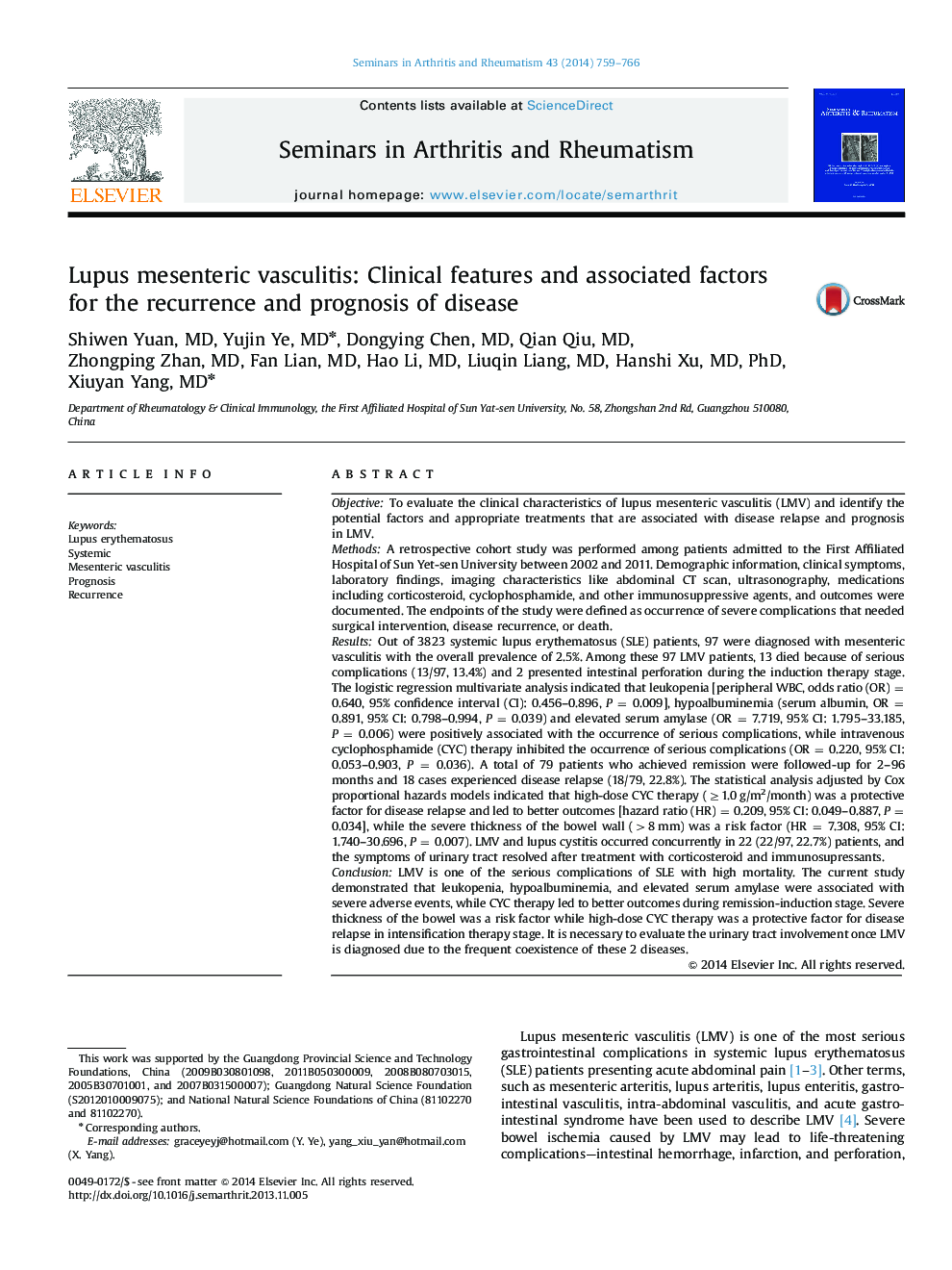| کد مقاله | کد نشریه | سال انتشار | مقاله انگلیسی | نسخه تمام متن |
|---|---|---|---|---|
| 2771436 | 1151747 | 2014 | 8 صفحه PDF | دانلود رایگان |
ObjectiveTo evaluate the clinical characteristics of lupus mesenteric vasculitis (LMV) and identify the potential factors and appropriate treatments that are associated with disease relapse and prognosis in LMV.MethodsA retrospective cohort study was performed among patients admitted to the First Affiliated Hospital of Sun Yet-sen University between 2002 and 2011. Demographic information, clinical symptoms, laboratory findings, imaging characteristics like abdominal CT scan, ultrasonography, medications including corticosteroid, cyclophosphamide, and other immunosuppressive agents, and outcomes were documented. The endpoints of the study were defined as occurrence of severe complications that needed surgical intervention, disease recurrence, or death.ResultsOut of 3823 systemic lupus erythematosus (SLE) patients, 97 were diagnosed with mesenteric vasculitis with the overall prevalence of 2.5%. Among these 97 LMV patients, 13 died because of serious complications (13/97, 13.4%) and 2 presented intestinal perforation during the induction therapy stage. The logistic regression multivariate analysis indicated that leukopenia [peripheral WBC, odds ratio (OR) = 0.640, 95% confidence interval (CI): 0.456–0.896, P = 0.009], hypoalbuminemia (serum albumin, OR = 0.891, 95% CI: 0.798–0.994, P = 0.039) and elevated serum amylase (OR = 7.719, 95% CI: 1.795–33.185, P = 0.006) were positively associated with the occurrence of serious complications, while intravenous cyclophosphamide (CYC) therapy inhibited the occurrence of serious complications (OR = 0.220, 95% CI: 0.053–0.903, P = 0.036). A total of 79 patients who achieved remission were followed-up for 2–96 months and 18 cases experienced disease relapse (18/79, 22.8%). The statistical analysis adjusted by Cox proportional hazards models indicated that high-dose CYC therapy (≥1.0 g/m2/month) was a protective factor for disease relapse and led to better outcomes [hazard ratio (HR) = 0.209, 95% CI: 0.049–0.887, P = 0.034], while the severe thickness of the bowel wall (>8 mm) was a risk factor (HR = 7.308, 95% CI: 1.740–30.696, P = 0.007). LMV and lupus cystitis occurred concurrently in 22 (22/97, 22.7%) patients, and the symptoms of urinary tract resolved after treatment with corticosteroid and immunosupressants.ConclusionLMV is one of the serious complications of SLE with high mortality. The current study demonstrated that leukopenia, hypoalbuminemia, and elevated serum amylase were associated with severe adverse events, while CYC therapy led to better outcomes during remission-induction stage. Severe thickness of the bowel was a risk factor while high-dose CYC therapy was a protective factor for disease relapse in intensification therapy stage. It is necessary to evaluate the urinary tract involvement once LMV is diagnosed due to the frequent coexistence of these 2 diseases.
Journal: Seminars in Arthritis and Rheumatism - Volume 43, Issue 6, June 2014, Pages 759–766
